
NGC 6240, also known as the Starfish Galaxy, is a nearby ultraluminous infrared galaxy (ULIRG) in the constellation Ophiuchus. The galaxy is the remnant of a merger between three smaller galaxies. The collision between the three progenitor galaxies has resulted in a single, larger galaxy with three distinct nuclei and a highly disturbed structure, including faint extensions and loops.
Luminous infrared galaxies or LIRGs are galaxies with luminosities, the measurement of brightness, above 1011 L☉. They are also referred to as submillimeter galaxies (SMGs) through their normal method of detection. LIRGs are more abundant than starburst galaxies, Seyfert galaxies and quasi-stellar objects at comparable luminosity. Infrared galaxies emit more energy in the infrared than at all other wavelengths combined. A LIRG's luminosity is 100 billion times that of the Sun.

APM 08279+5255 is a very distant, broad absorption line quasar located in the constellation Lynx. It is magnified and split into multiple images by the gravitational lensing effect of a foreground galaxy through which its light passes. It appears to be a giant elliptical galaxy with a supermassive black hole and associated accretion disk. It possesses large regions of hot dust and molecular gas, as well as regions with starburst activity.

Ionization cones are cones of ionized material extending from active galactic nuclei, predominantly observed in type II Seyfert galaxies. They are detected through their emission of electromagnetic radiation in the visible and infrared parts of the spectrum. The main method of observation is through spectroscopy, using spectral line analysis to measure the shape of the ionized region and the condition of the material such as temperature, density, composition, and degree of ionization.

Markarian 231 is a Type-1 Seyfert galaxy that was discovered in 1969 as part of a search of galaxies with strong ultraviolet radiation. It contains the nearest known quasar. Markarian 231 is located about 581 million light years away from Earth, in the constellation of Ursa Major.

NGC 4388 is an active spiral galaxy in the equatorial constellation of Virgo. It was discovered April 17, 1784 by Wilhelm Herschel. This galaxy is located at a distance of 57 million light years and is receding with a radial velocity of 2,524 km/s. It is one of the brightest galaxies of the Virgo Cluster due to its luminous nucleus. NGC 4388 is located 1.3° to the west of the cluster center, which translates to a projected distance of ≈400 kpc.

NGC 1614 is the New General Catalogue identifier for a spiral galaxy in the equatorial constellation of Eridanus. It was discovered on December 29, 1885 by American astronomer Lewis Swift, who described it in a shorthand notation as: pretty faint, small, round, a little brighter middle. The nebula was then catalogued by Danish-Irish astronomer J. L. E. Drayer in 1888. When direct photography became available, it was noted that this galaxy displayed some conspicuous peculiarities. American astronomer Halton Arp included it in his 1966 Atlas of Peculiar Galaxies. In 1971, Swiss astronomer Fritz Zwicky described it as a "blue post-eruptive galaxy, compact patchy core, spiral plumes, long blue jet SSW".
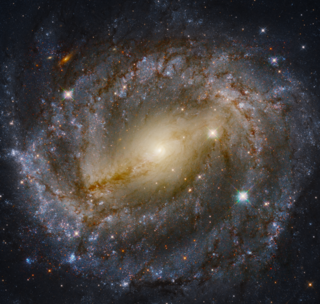
NGC 5643 is an intermediate spiral galaxy in the constellation Lupus. Based on the tip of the red-giant branch distance indicator, it is located at a distance of about 40 million light-years. NGC 5643 has an active galactic nucleus and is a type II Seyfert galaxy.

NGC 2623/Arp 243 is an interacting galaxy located in the constellation Cancer. NGC 2623 is the result of two spiral galaxies that have merged. Scientists believe that this situation is similar to what will occur to the Milky Way, which contains the Solar System, and the neighboring galaxy, the Andromeda Galaxy in four billion years. Studying this galaxy and its properties have provided scientists with a better idea of the coming collision of the Milky Way and the Andromeda. Due to NGC 2623 being in the late stage of merging, the compression of the gas within the galaxy has led to a large amount of star formation, and to its unique structure of a bright core with two extending tidal tails.

NGC 3256 is a peculiar galaxy formed from the collision of two separate galaxies in the constellation of Vela. NGC 3256 is located about 100 million light-years away and belongs to the Hydra–Centaurus Supercluster complex. NGC 3256 provides a nearby template for studying the properties of young star clusters in tidal tails. The system hides a double nucleus and a tangle of dust lanes in the central region. The telltale signs of the collision are two extended luminous tails swirling out from the galaxy. The tails are studded with a particularly high density of star clusters. NGC 3256 is the most luminous galaxy in the infrared spectrum located within z 0.01 from Earth.

NGC 7469 is an intermediate spiral galaxy in the constellation of Pegasus. NGC 7469 is located about 200 million light-years away from Earth, which means, given its apparent dimensions, that NGC 7469 is approximately 90,000 light-years across. It was discovered by William Herschel on November 12, 1784.

NGC 7130 is a spiral galaxy located in the constellation Piscis Austrinus. It is located at a distance of about 220 million light years from Earth, which, given its apparent dimensions, means that NGC 7130 is about 100,000 light years across. It was discovered by John Herschel on September 25, 1834, and discovered independently by Lewis Swift on September 17, 1897. The location of the galaxy given in the New General Catalogue was off by 30 arcminutes in declination from the location of the galaxy.

NGC 7674 is a spiral galaxy located in the constellation Pegasus. It is located at a distance of circa 350 million light years from Earth, which, given its apparent dimensions, means that NGC 7674 is about 125,000 light years across. It was discovered by John Herschel on August 16, 1830.
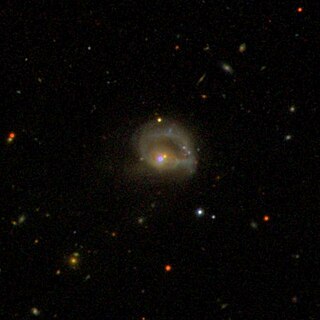
NGC 985 is a ring galaxy in the constellation of Cetus. It is located about 550 million light years away from Earth, which means, given its apparent dimensions, that NGC 985 is approximately 160,000 light years across. It was discovered by Francis Leavenworth in 1886. It is a type 1 Seyfert galaxy.

NGC 1386 is a spiral galaxy located in the constellation Eridanus. It is located at a distance of circa 53 million light years from Earth, which, given its apparent dimensions, means that NGC 1386 is about 50,000 light years across. It is a Seyfert galaxy, the only one in Fornax Cluster.
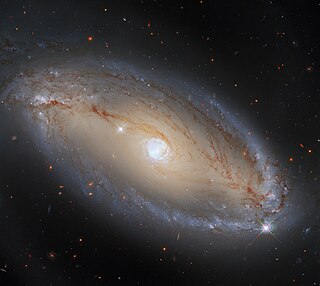
NGC 5728 is an active barred spiral galaxy located 146 million light years away in the southern constellation of Libra. It was discovered on May 7, 1787 by William Herschel. The designation comes from the New General Catalogue of J. L. E. Dreyer, published in 1888. It has an apparent visual magnitude of 13.40 and spans an angle of 3.4 arcminutes. The galaxy shows a red shift of 0.00935 and has a heliocentric radial velocity of 2,803 km/s. It has an estimated mass of 72 billion times the mass of the Sun and stretches around 30 kpc across.
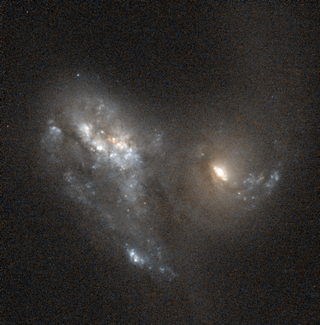
NGC 7592 is an interacting galaxy system located 300 million light years away in the constellation Aquarius. It was discovered by William Herschel on September 20, 1784. The total infrared luminosity is 1011.33 L☉, and thus it is categorised as a luminous infrared galaxy. One of the galaxies hosts a type 2 Seyfert nucleus.
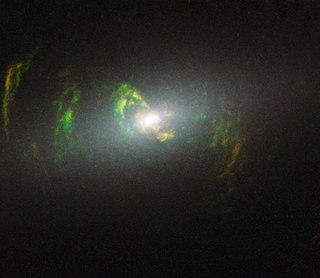
NGC 5252 is a lenticular galaxy located in the constellation Virgo. It is located at a distance of about 220 to 320 million light years from Earth, which, given its apparent dimensions, means that NGC 5252 is about 100,000 light years across. It was discovered by William Herschel on February 2, 1786.

Markarian 590, also known as NGC 863, NGC 866, and NGC 885, is a spiral galaxy located in the constellation Cetus. It is located at a distance of about 300 million light years from Earth, which, given its apparent dimensions, means that NGC 863 is about 110,000 light years across. It is a change looking Seyfert galaxy.

UGC 5101 is a galaxy merger located in the constellation Ursa Major. It is located at a distance of about 530 million light years from Earth. It is an ultraluminous infrared galaxy. The total infrared luminosity of the galaxy is estimated to be 1011.95 L☉ and the galaxy has a total star formation rate of 105 M☉ per year.



















